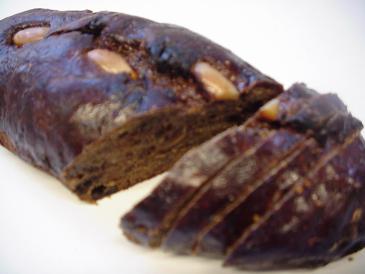 |
[ZAWiW] [gemeinsamlernen] [LiLL] | ||
|
|
||
| home | ||
|
|
Doris Becker | |
|
|
Ruth Dassler | |
|
|
Jutta Gotthart | |
|
|
Anneliese Haas | |
|
|
Erich Regula | |
|
|
Hildegard Keller | |
|
|
Lilo Nold | |
|
|
M.&H. Schwiebert | |
|
|
Brigitte Trojahn | |
|
|
Agathe Wende | |
 |
||
Hildegard Keller
Stand:Hutzelbrot
 Hildegard Keller
Hildegard Keller
Word Explanations
Because the proper names "Hutzelbrot", "Hutzeln",
Dörrkammer", "Backhäusle" are no current expressions, first of
all here you will get some explanations:
"Hutzeln" = dried pear slices.
"Dörrkammer" = kiln dry - a small room in the "Backhäusle"
where the sliced pears were dried.
"Backhäusle" = formerly it was a small house in the village, where
there was a baking oven which was used by all families.
Introduction
The word "Hutzelbrot" brings memories of the cosy atmosphere of
pre-Christmas and Christmas days, when the scent of cinnamon and other spices
drifts mysteriously through the house.
Hutzelbrot is a traditional baker's ware of Christmas time. In cold days it is -
basted with butter - served with wine or punch. It is mostly known in Schwabia
and Austria. But my first remembrance of Hutzelbrot is attached to Frankfurt.
Because this memory goes to the early childhood, when the splendidly illuminated
streets and people full of expectations touched my innocent soul, for me there
is no better Hutzelbrot than the one from Frankfurt.
|
Description
The traditional bakery product Hutzelbrot means a sort of bread, where
boiled kiln - dried pears are mixed with bread dough. Its origin is mainly
in the region of the Alps and in Vienna. |
 |
History
Hutzelbrot is one of the oldest Christmas breads. (More information and
details could not be researched.)
- Formerly it was made without any addition of sugar or honey. The dough got its
sweetness
only from the baked Hutzeln (also known as Kletzen or Klötzchen).
- Hutzeln were made in the "Dörrkammer" of the public baking-houses.
In the course of
history other kiln dried fruit, nuts and flavour enhancers were added.
- Today there are various recipes. Nearly every baker has his own secret
ingredients for his "Hutzelbrot" or "Klötzenbrot".
Tradition
You were not allowed to cut Hutzelbrot before Christmas Eve or St. Sephe's Day (Dec. 26). It had to be produced with the utmost care. The failure meant the death of the farmer's wife. The girls gave the "Klötzchenschörzel" (the end of the bread) to their lovers as a present. If the surface of a cut was smooth (because the dough was well kneaded) it meant a positive love oracle, if the surface of cut was rough it meant the end of a liaison and if a piece of wire was baked inside the bread it emphasized this even more. A girl was never allowed to eat the "Scherzl" (the end of the bread) herself, except she wanted to have twins. The sweet bread had to be consumed till Epiphany as at this time food offerings for the souls ended.
Recipe
There are no recipes included as it would be beyond the scope of a simple presentation of this bread. If you are interested in recipes please contact the author of the article.
Literature
In this tale "Das Stuttgarter Hutzelmännlein" E. Mörike has
created a memorial to the Hutzelbrot.
- Brot und Brauchtum (Landesverlag Linz).
- Das Buch der Brauchtumsgebäcke (BLV Verlag Wien).
My personal relationship to Hutzelbrot
I have already mentioned it in the introduction, but it was still deepened by an experience with a nice old Swabian lady. For her the production of Hutzelbrot meant nearly a ritual act. She herself prepared all ingredients for Hutzelbrot till her old age. In a small rack-wagon she took the round small loaves of bread to a baker. The shining new Hutzelbrote were a welcome present for friends or relatives in the pre-Christmas an Christmas season.
